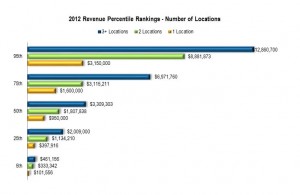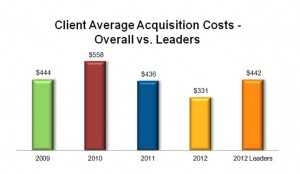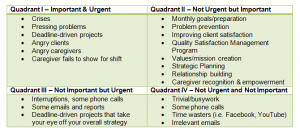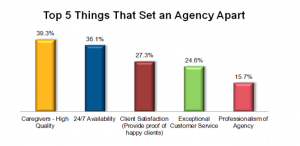By Aaron Marcum,
Founder of Home Care Pulse and the Annual Benchmarking Study
It is an exciting time to be a part of the private duty home care industry, perhaps one of the fastest growing industries in and outside of healthcare. In fact, based on the profiles of our participants this year, the number of private duty home care agencies has grown by at least 104% since 2007! This kind of growth is not going to change its course anytime soon. In fact, everything points towards its continuation for several years to come due to the increasing need for in-home care by the largest segment of our population, baby boomers.
For some of you, this might be a discouraging statistic. No one faults you for feeling this way. We have all experienced more competition. However, my purpose in writing this article is to provide everyone with the peace of mind to go forward with faith. I learned after many years of attending Sunday School that faith is a principle of action. To take advantage of this huge industry growth over next few years, you must take action and find ways to stand out.
This brings me to the purpose of the 2013 Private Duty Benchmarking Study. First of all, the purpose extends far beyond just presenting data about the private duty home care industry. Though interesting for some, that would be boring for others. From the 1st edition to the 4th, our primary goal in conducting these studies is to help private duty home care owners and executives grow their businesses, regardless of where they are today.
The data comparisons we present are more than just numbers on a page. They represent the best practices of 617 agencies throughout the country. Once you obtain a copy of the study, I invite you to set a full day aside and carefully review the information this report contains and see how you can use it to grow your business. I am confident this will be one of the most valuable days you will spend on your business all year long.
The most important thing you can do when going through the study is to ask yourself questions related to areas of your business you are considering changing or improving upon. I have provided a few examples of questions you might ask and how you can “read between the data” to help grow your home care business this year.
If I expand to a second location, how will that influence my overall revenue?
First of all, take a look at the “Revenue Percentile Ranking by Number of Locations” graph above, also located in The Study, and take note of how your agency compares to those with one location. What percentile are you in? As you’ll note, typically those who expand to two locations nearly double their revenue if they are around the 50th percentile. However, if you find yourself around the 95th percentile, growing to a second location may be even more advantageous for your company because it shows nearly three times the revenue growth if you expand from one location to two. Why such a big jump at this point? 1) You have more capital to establish a second location faster, and 2) at this level you start to create a brand that is recognizable even in neighboring areas.
Should I raise my billing rates as a way to increase revenue?
This is the million dollar question, which may really be the case for some of you. Let’s see what the Leaders (those who billed over $2,000,000 in revenue in 2012) are charging for their services. The Leader group was represented by 129 different companies, or approximately 21% of the total participants.
On average, the Leaders in the study bill 50 cents more an hour, per client. Though this may seem like a very small difference, for the Leaders this represents an average annual increase in revenue of $75,348. The question is, can you justify raising your rates? Have you created enough perceived value that raising your rates will have very little negative impact on your clients? Do you provide a premium service? What unique value do you provide that your competitors do not? How do your rates compare with your competition? Most importantly, do you provide your clients with an exceptional experience?
For example, many of you may think of Home Care Pulse as simply the creator of the Annual Benchmarking Study. However, we do so much more. We provide satisfaction research and quality management to over 500 home care agencies throughout North America, which our customers rely on to improve quality and provide proof of the quality of care they provide. On behalf of our private duty home care customers, we interview thousands of consumers who use home care services. Based on the large amount of feedback we receive, it is clear to me that consumers will pay above-average prices for above-average service.
Should we cut our marketing expenses until the economy shows stronger signs of recovery?
Please allow me to brag about my older brother for a moment. I promise, it does relate to my point here. He is a highly-accomplished ad agency owner and executive with more awards to his name than I care to count. A few years ago, he won $100,000 for producing the #1 radio spot in the United States, known as the highly-coveted “Mercury Award.”
When I first started my home care agency, shortly after the tragic events of September 11th, he gave me some wonderful advice that I will never forget. He said something along the lines of, “Aaron, the marketing budget is often the first thing to go when times get tough for businesses. Don’t do it! Your marketing budget should be the last thing to go. When the economy slumps that is a great opportunity to gain market share by implementing a well-thought-out marketing strategy.”
It appears the Leaders in the study follow the same line of thinking. See the graph below, “Client Average Acquisition Costs – Overall vs. Leaders.” Leaders spend on average $442 in marketing/sales costs to acquire a new client. Interestingly enough, this amount has seen very little change among the Leaders during the slump in the economy. It appears they have not cut their marketing budgets, and still they continue to see growth. However, in contrast, all other agencies appear to have cut their marketing budgets from a $558 average acquisition cost in 2010 to a $331 average acquisition cost in 2012.
To repeat the words of my brother, “Don’t do it!” Carefully structure a solid marketing and sales strategy and continue to invest in it.
Should I invest more of my time, energy, and money into improving the overall client experience?
The answer to this question might be obvious to some, but I am amazed by how many home care business owners, sometimes unconsciously, place this as low priority in their business. Too often they are putting out fires and giving attention to whomever or whatever is screaming the loudest at that time.
If you’ve read the book, “First Things First” by Stephen Covey, you’ll remember he talks about four “Time Quadrants” and how many of us spend much of our time in Quadrants I, III, and IV, but not enough in Quadrant II. His illustration of these quadrants is below along with some examples both from his book and those that relate to home care:
Implementing a Quality Satisfaction Management Program and striving to consistently improve the overall satisfaction of your clients is typically a Quadrant II activity. As you see above, Quadrant II activities should be where owners and executives of home care businesses spend the majority of their time! Unfortunately, too often, Quadrant II activities take a back seat to the other three quadrants. Consistently improving satisfaction and developing a strong Quality Management Program is vital to setting your agency apart from the competition.
In the Online Study Survey, we asked participants the following question: “When speaking with potential clients, referral sources, and your community, what are the top three things you tell them that sets your agency apart from your competition?”
They were able to choose from 32 different categories, ranging from being “Dementia Care Experts” to offering “Affordability.” In the “Top 5 Things That Set an Agency Apart,” as illustrated in the graph below, all five revolve around one central theme, improving the overall client satisfaction of their clients/families. This is no coincidence. Focusing on improving quality satisfaction, especially if you establish a formalized Quality Management Program, is perhaps the best use of the time, energy, and money you will ever spend on behalf of your business.
In Conclusion
I could go on and on, providing many more examples of how you can “read between the data” of this powerful study. Please go through this study section by section. In the Executive Summary make sure to review the participation summary. Here you’ll find a great deal of information on our participants so you can feel for the various comparison groups we included.
Next, visit the Quality Awards section. In this section we explain the methodology behind our Best of Home Care® Awards and provide more information regarding our Quality Management Program. We also announce the 300+ Best of Home Care® Winners. Then dive deep into the Finance, Sales & Marketing, Operations, Recruitment and Retention, and Licensing Sections of the study. The Recruitment and Retention Section is new this year and full of powerful information on this subject.
We were delighted that Stephen Tweed and his team at Leading Home Care work with us on this new section. Their insights and direction were extremely helpful. In each of these sections, you will discover many benchmarks and insights related to various areas of your business.
In fact, we invite you to join us this Thursday, April 25th for a special webinar on the results of the 2013 Private Duty Benchmarking Study. This is a great way to get the most out of your copy of the 2013 Study, and if you haven’t already purchased your copy, you can get the 2013 Study (regularly priced at $299) and the webinar (regularly priced at $49) together for only $249.
Register or read more about this unique learning opportunity at http://www.homecarepulse.com/webinar-industry-4-25-13/.
I invite you to take my challenge and review this study thoroughly. I am confident that if you give attention to its application, you will find many powerful insights to grow your agency for years to come.
About The Author: Aaron Marcum is the Founder and CEO of Home Care Pulse, the leader in research and quality management for the private duty home care industry. He is also the creator of the Annual Private Duty Benchmarking Study. Before starting Home Care Pulse, Aaron owned and managed his own successful private duty home care agency in Salt Lake City, Utah. He has a passion for helping this industry grow, and is well-known for his leadership among entrepreneurs in home care. To learn how the Home Care Pulse Quality Management Program can help you achieve long-term growth and success, contact Aaron and his team at amarcum@homecarepulse.com or visit www.homecarepulse.com.







